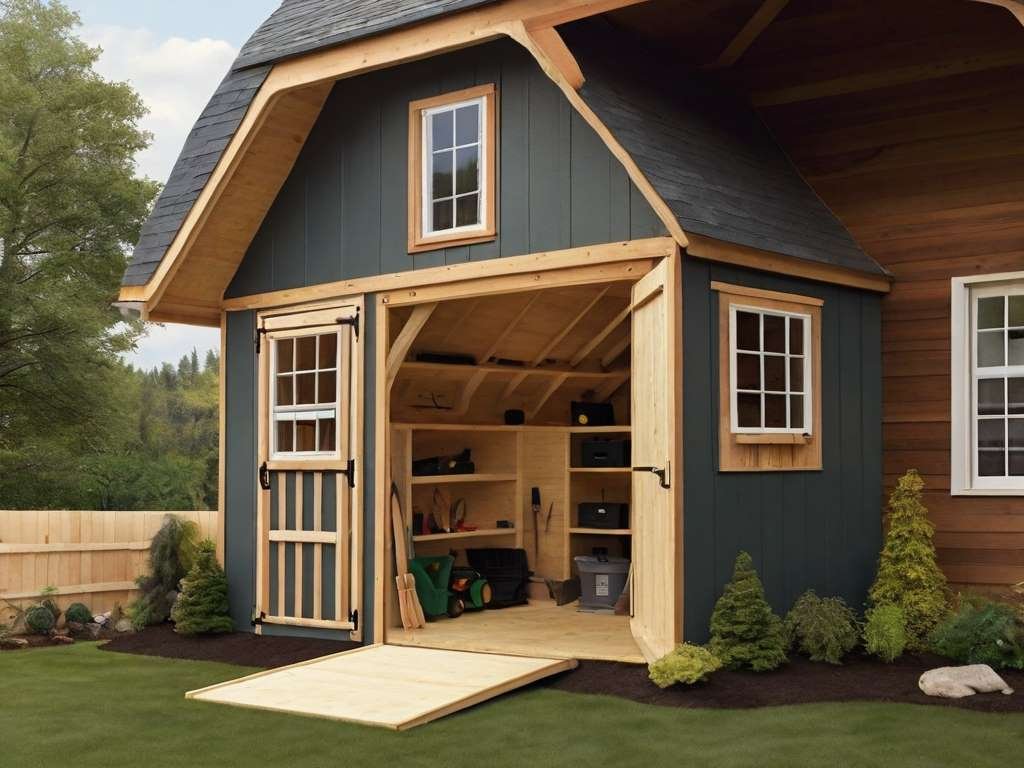Do you want to increase storage space while still adding timeless appeal to your home? Gambrel shed with lean-to might be the answer.
Whether you’re a DIY enthusiast or looking for readymade choices, this blog covers everything from design concepts to construction.
Building a shed with lean-to elegantly integrates use and design, giving improved storage while adding an attractive architectural element to your outdoor space.
Considerations and Options for Customization
Making options that suit your interests and needs is part of designing your gambrel shed. Consider color, material, and architectural features as customizing choices.
Consider the shed’s intended use, such as storage, workshop, or perhaps a pleasant retreat. Consider the surrounding surroundings as well as the overall beauty of your home.
Choosing the Correct Dimensions and Size
It is important to determine the size and dimensions of your gambrel shed. Examine your property’s available space as well as any local zoning requirements.
Consider the objects you intend to keep or activities you wish to facilitate within the shed. Whether the building is 8×10 or bigger, meticulous planning provides excellent operation.
Windows, Doors, and Other Features Included
Windows and doors are crucial to the functioning and beauty of your gambrel shed.
Natural light from windows may make the room more attractive, while strategically positioned doors provide for simple access.
To customize your shed, consider amenities like as ventilation systems, skylights, and even ornamental components.
Technical Specifications: Wall Height, Door Dimensions, and Window Positioning
Precision in technical parameters enables functional and visually beautiful shed design, from appropriate wall height to precisely calculated door proportions and strategically positioned windows.
Wall Height
The overall look and storage capacity of your gambrel shed is affected by its wall height. Higher walls offer greater vertical storage space as well as the possibility of a loft.
When deciding on wall height, consider your storage requirements as well as the overall proportions of the shed.
Door measurements
Select door measurements that will allow you to keep the largest goods in the shed. Consider elements such as simplicity of use and security features.
To ensure lifespan, use sturdy materials for doors.
Window Positioning
Positioning windows strategically improve natural light and ventilation. Consider the orientation of the shed to optimize sunlight.
Choose window sizes that balance beauty and utility while preserving the shed’s structural integrity.
Construction Plans and Materials
Navigating building designs and choosing premium materials sets the stage for a successful shed installation, assuring structural integrity, longevity, and a customized touch to your outdoor space.
DIY vs. Manufactured Alternatives
Choose if you want to do it yourself or buy a ready-made solution. DIY projects provide users with hands-on experience and customization.
Prefabricated kits, on the other hand, provide convenience and frequently include extensive assembly instructions.
When making this option, consider your talents, time commitment, and money.
Plans for 8×10 Gambrel Roof Shed
Plans for an 8×10 gambrel roof shed with a lean-to are a popular alternative for people looking for a specified size.
Explore various options available online or from trusted merchants. These designs often contain extensive directions, material lists, and, in some cases, 3D models to help you navigate the construction process.
Small Gambrel Roof Shed Plans with Lean-To:
Consider plans for a small gambrel roof shed with a lean-to if you have limited space or special needs.
Smaller sheds are more adaptable and may fit into smaller locations while retaining the benefits of the gambrel roof style.
Technical Specifications: Materials Recommendations, Insulation Options, and Foundation Details
Choosing appropriate materials, investigating insulation alternatives, and precisely designing foundation details are important technical features that ensure long life, energy efficiency, and a stable foundation for your gambrel shed with lean-to.
Recommended Materials
The materials you use have a big influence on the longevity and beauty of your shed. Wood, metal, and vinyl are all common materials.
When choosing materials, consider weather resilience, maintenance requirements, and local building rules.
Options for Insulation
Insulating the gambrel shed is critical, especially if you intend to utilize it for more than just storage. Consider fiberglass, foam board, or spray foam as insulation choices.
Proper insulation provides comfort while also protecting your stored things.
The foundation is responsible for the shed’s stability and lifespan. Concrete slabs, piers, and skids are all options.
Select a foundation type depending on your local climate, soil conditions, and the planned usage of the shed.
Recognizing Gambrel Roofs
Gambrel roof, distinguished by two slopes on each side, has both aesthetic and functional benefits.
The lower, steeper slope gives more headroom and storage space, making it excellent for building shed lofts.
Benefits of Gambrel Roofs for Sheds
Rainwater and snow are effectively shed by gabled roofs, reducing structural difficulties. Higher storage capacity and traditional barn-like characteristics of design make it a popular choice among builders and homeowners.
Visual Appeal & Traditional Barn Aesthetics
Gambrel roof’s ageless beauty gives countryside style to any house. Whether in the country or city, the barn-like characteristics of your shed make it not only utilitarian but also visually beautiful.
Technical Specifications: Roof Pitch, Truss Design, and Structural Considerations
Fine-tuning technical criteria, such as roof pitch, truss design, and structural concerns, creates the framework for a strong and visually beautiful gambrel shed with a lean-to.
Roof Pitch
Based on your climate and design choices, choose a roof pitch of 20 to 40 degrees. This promotes adequate drainage as well as visual harmony.
Truss Design
Investigate truss configurations such as Pratt or Howe, taking into account parameters such as shed span and purpose. Customize truss design to match your structural needs.
Structural Considerations
While gambrel roofs are strong, be sure your shed satisfies safety regulations. Consult structural engineers to ensure that quality materials are used and that construction codes are followed.
Lean-To Additions Idea
A lean-to is an excellent addition to any shed design, adding more room and improving practicality.
It offers a variety of functions, from storage to establishing a workplace, and it complements the gambrel roof.
Advantages of Including a Lean-To
Lean-tos provide extra storage without detracting from the beauty of the gambrel shed. They’re adaptable, allowing for modification and imaginative applications.
Options for Visual Enhancement and Customization
Incorporate a gambrel barn with lean-to-plains to improve the visual attractiveness of your shed.
Matching or contrasting design components are available for customization, ensuring that the lean-to compliments the overall aesthetics.
Construction Instructions
Those who are finding ways how to build a gambrel roof. It is the right location where you can follow up with simple and understandable instructions for solutions.
Preparation of Foundation and Site
Begin the building process by prepping the land and laying a firm foundation. Remove any rubbish and vegetation from the area.
Ensure correct soil leveling and compaction depending on the foundation type you choose, such as concrete slabs, piers, or skids.
Gambrel Roof with Lean-To Framing:
Begin framing the gambrel roof barn with a lean-to. Stick to the design and truss arrangements specified in your blueprints.
Assemble roof trusses, making certain that they are firmly secured. Align lean-to with the main structure by extending the framework to encompass it.
To ensure structural integrity, pay special attention to dimensions and angles.
Door, Window, and Other Feature Installation
Once the basic structure is complete, install doors and windows. To retain structural strength, provide correct framing around apertures.
Consider any extra features, such as freshening systems or skylights. Attach roofing materials, siding, and other external pieces securely.
Gable and Gambrel Shed Comparison
There is one famous confusion which is, what is the difference between gable and gambrel sheds? Here is the brief answer.
Gable Roof Definition and Characteristics
Before proceeding with comparison, it is important to understand what a gable roof is. A gable roof is a triangular-shaped roof with two slopes that meet at a ridge. It is a simpler design than a more complicated gambrel roof.
Primary Distinctions between Gable and Gambrel Sheds
Gable roofs have basic and uncomplicated aspects, whilst gambrel roofs have a more unique and barn-like appearance. Take into account your aesthetic tastes as well as how well each style matches your house.
Interior Space: Because of its steeper bottom slope, gambrel roofs give additional useable interior space, particularly in the form of a loft or upper level.
Because of their more symmetrical construction, gable roofs may not provide as much internal room.
Gable roofs are often easier to build, making them ideal for do-it-yourself projects or people with minimal building expertise.
Gambrel roofs can be more difficult to construct due to their truss designs and angles.
Drainage and Snow Shedding: Because of its steep bottom pitch, gambrel roofs are excellent at shedding rainfall and snow.
Gable roofs are also useful for drainage, although they may not shed snow as well in locations with severe snowfall.
Expensive in Constructions: Because of its simpler form and simplicity of construction, gable roofs may be less expensive.
Gambrel roofs may need more materials and labor, increasing total prices.
Selecting the Best Design for Your Needs
When deciding between gable and gambrel shed, consider your unique goals, preferences, and ability level.
If affordability, simplicity, and convenience of construction are important considerations, a gable roof may be the best option.
Gambrel roof is the right match if you want greater internal space, and a unique look, and are ready to handle a more involved build.
Gable roofs normally have a pitch of 20 to 30 degrees, offering a balanced and symmetrical appearance. When choosing a gable roof, consider considerations such as local weather conditions, desired interior space, and budget.
Final Thought
Understanding the distinctions between a gambrel shed with a lean-to is essential in the quest to build your ideal storage area with a touch of vintage style.
Begin your shed-building adventure with Freedomz Storage, where detailed guidelines, technical insights, and creative ideas come together.
From designing an ideal gambrel shed with lean-to to understanding the differences between gable and gambrel roofs.
Whether you choose a do-it-yourself project or manufactured kit, the decision between gable and gambrel roof comes with its own set of issues.
Remember to follow local building rules, consult with specialists when necessary, and prioritize safety throughout the construction process as you begin your shed-building adventure.
Share your experiences, ask questions, and connect with the shed enthusiast community. Whether you’re a seasoned builder or a first-time do-it-yourselfer, your unique vision and effort will result in beautiful and useful construction that will add value to your property for years to come.
Thank you for joining us on this journey to build a gambrel shed with lean-to.
Happy construction!

